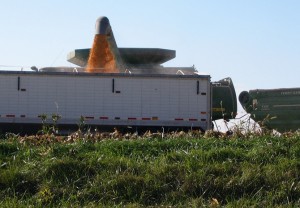Spring Waxing Flower Moon
The drought took a hit last night and this morning. We had almost an inch of rain and it all fell right in the window when I needed to hive my bees. Wouldn’t you know?
Today had a bit of the comic routine to it. I got up this morning ready to hive the bee package I picked up last evening. All I had to do was put the foundation into the frames. The foundation is a beeswax coated sheet on which the bees build their hexagonal cells that house larvae, pollen and honey. It’s flimsy and I remembered from somewhere that it just snapped right in. Right.
The first two I tried I bent the metal holding the edges together and in bending it loosed the beeswax from its sheet. So, I went on the internet to see if I had the idea wrong. Well, I knew I had it wrong, I went on the net to find out how to fix it. I came away convinced that you had to build foundation into the frame. Which meant I had ten empty frames I couldn’t use.
OMG. I have bees to hive and no frames with foundations. Long story short I drove back out to Nature’s Nectar where the guy said, “Bullshit. Let me show you.” And so he did. It was a long drive for a lesson in frames and foundations, but worth it.
When I returned, I did indeed pop the foundations in the frame. All in knowing how.
So, I gathered the copper clad hive cover, the hive box with its ten frames and foundations, the bottom board, the entrance reducer and a top board that goes over the topmost hive box. My plan was to do the complete reversal on the existing colony as Jim of Nature’s Nectar suggested, take the feeder off of it and reuse it on the new colony.
The smoker, still the least understood part of the business right now for me, lit, I went out to the colony that stung me five times just a week ago. Since this was an extended operation, I put on the gloves this time. The bees got mad, they don’t leave home much on rainy days and don’t like getting off their loungers while watching the bee olympics or whatever. Well protected, I went on about the business of putting the top most hive box on the bottom, the bottom most box on top, removing the feeder and reclosing the hive.
No stings. I had the feeder. It was all good. Except. Several, by several I mean a lot, of bees had set up house keeping in the area under the feeder. They did not want to leave. Not even after I shook the feeder, whacked it on hay bales and generally tried to evict the squatters. I couldn’t put it on the other hive with strangers living in it, so I had to go to the hardware store and get pails of the right size to make feeder pails. Which meant I had to get an empty hive box from downstairs to cover the pail. After taking the hive box out, I realized I had to go back inside to get a pollen patty.
Finally, I had everything and proceeded to whack the bee package on the ground to move all the bees to the bottom of the wood and wire package. The feeder, a tin can with holes in it, pries out and leaves a hole through which you pour the bees onto the bottom of the hive box from which you have removed the four central frames just for this purpose. The bees, after being liberally sprayed with sugar and water syrup, should fall to the bottom of the hive. There you spread them around. That worked for most of them, but some of them didn’t get the memo.
So, I had an opportunity to test whether I have a developing allergy to bee stings. Nope. I’m just fine. The bees are in their new hive, and so, I hope, is the queen whom I’d forgotten to remove in my excitement. When I did get her out, I released her by the direct release method–pry up the screen covering her small box and let her walk out–but some of her subjects took it upon themselves to sting me right about then, so I’m not sure she’s in the hive. Though I think she is. I’ll find out in a week when I check the frames to see if there any larvae.
Anyhow, the bee day has ended. Tomorrow is plant day. Time in the garden. After that, who knows?
 not yet over and will go on until the ground threatens to become hard.
not yet over and will go on until the ground threatens to become hard.